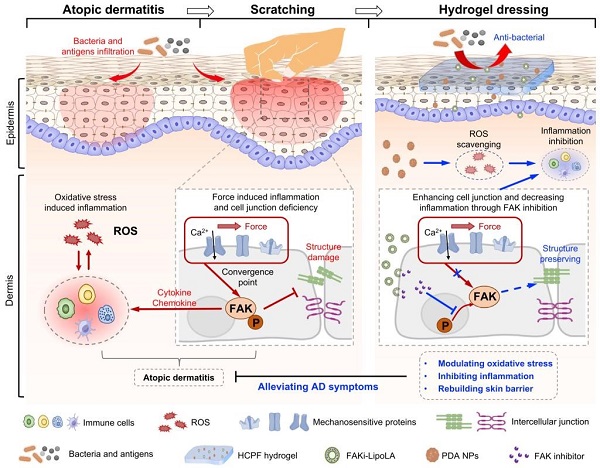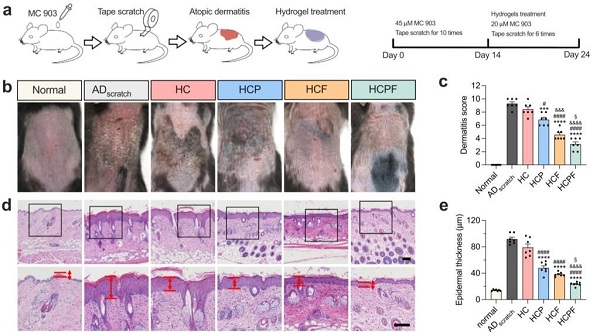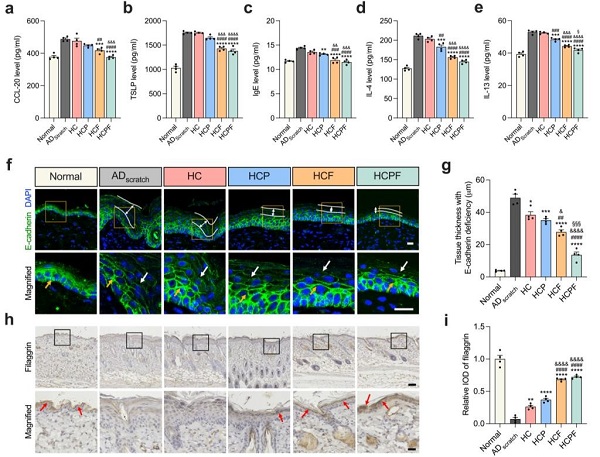XJTU medical-industrial crossover team achieves the first force-chemical synergistic treatment for atopic dermatitis

Figure 1 Schematic diagram of hydrogel dressing for force-chem synergistic treatment of atopic dermatitis
The Institute of Bionic Engineering and Biomechanics (BEBC) of the School of Life Sciences and Technology of Xi'an Jiaotong University (XJTU) has developed a multi-functional hydrogel skin dressing based on the intersection of mechanics, materials science and dermatology. This is the first force-chemistry synergistic treatment for atopic dermatitis, taking the "large medical science + strong engineering" model of Jiaotong University as a carrier and taking full advantage of multidisciplinary intersection and integration of science and medicine.

Figure 2 Force-chemical synergistic treatment with HCPF hydrogel dressing can relieve AD symptoms
This work demonstrates that enhanced phosphorylation of Focal adhesion kinase (FAK), a key protein of the mechanosignaling pathway, is associated with scratching. In a mouse model of AD, mechanical scratching not only exacerbated AD symptoms, but also enhanced the level of phosphorylated FAK in tissues. Subsequently, the team developed a borate ester-based adhesive, stretchable, self-healing multifunctional hydrogel dressing (HCPF) loaded with polydopamine nanoparticles (PDA NPs) for scavenging reactive oxygen species and liposome-loaded FAK inhibitors (FAKi-lipo) for the synergistic treatment of AD.
This self-healing and antimicrobial hydrogel is suitable for the unique scratching of AD skin and bacterial environment. At the cellular level, blocking cell mechanics signaling by inhibiting FAK effectively reduces the secretion of inflammatory factors due to large strain stretch and the disruption of E-Cadherin, a key protein for intercellular junctions. At the animal level, FAK inhibition reduced skin barrier breakdown under scratching as well as the level of skin inflammation. HCPF hydrogel dressings integrating FAK inhibition and ROS scavenging achieved optimal AD therapeutic results in a force-chemical synergistic manner.

Figure 3 Inhibition of FAK phosphorylation reduces scratch-induced skin barrier damage
This work was published online in Nature Communications under the title "Hydrogel dressing integrating FAK inhibition and ROS scavenging for atopic dermatitis". The Key Laboratory of Biomedical Information Engineering, Ministry of Education, Xi'an Jiaotong University is the first author and corresponding author of the paper. The first authors of the article are Dr. Jia Yuanbo from the School of Life Sciences, Xi'an Jiaotong University and HuJiahui from the Second Affiliated Hospital of Xi'an Jiaotong University. The corresponding authors are Prof. Xu Feng from the School of Life Sciences, Xi'an Jiaotong University and Prof. Geng Songmei from the Department of Dermatology, Second Affiliated Hospital of Xi'an Jiaotong University.

